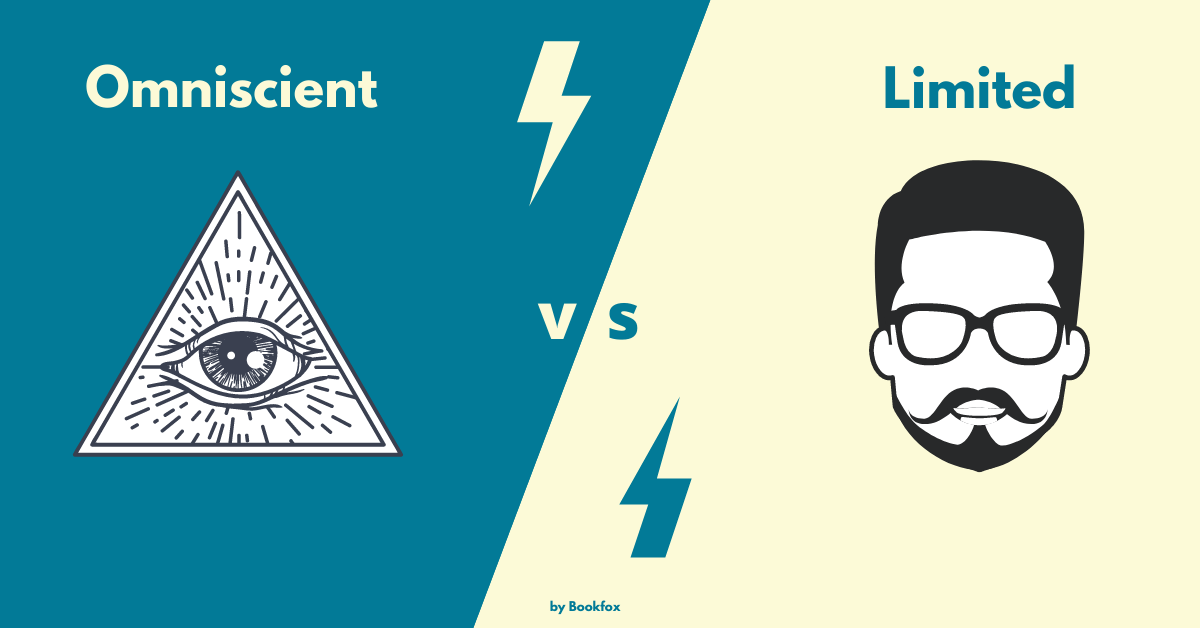 Writers spend a lot of time worrying about point of view, unless they don’t, in which case they are destined to be rejected by literary agents and editors everywhere.
Writers spend a lot of time worrying about point of view, unless they don’t, in which case they are destined to be rejected by literary agents and editors everywhere.
Point of view is critical to a book’s success. It’s also one of the most common things new writers trip over, right up there with “show, don’t tell.”
The main mistake that writers make with point of view is mixing up third person limited with third person omniscient.
I mean, nobody mixes up first person with second person, do they? Or omniscient with first person?
Nope, the #1 all-time error in point of view is limited/omniscient screw ups.
Third Person Limited

Third person limited is the most commonly used viewpoint. The writer allows the reader into the innermost thoughts, feelings, perceptions and prejudices of the point-of-view character.
Advantages of third-person limited:
- adaptable to multiple viewpoints (it’s called “roving” 3rd person) but less adaptable than omniscient
- writer is able to add suspense, because the reader is limited to knowing what the POV character knows
Disadvantages:
- If you’re not careful, you can shift perspectives, making things confusing
- more difficult for readers to bond with the POV character
Harry Potter is written in third person limited, with almost all of the action from Harry’s perspective (except for the first chapter in the first book, which is third person omniscient). There are a few occasions where the story is told from someone else’s perspective, but these are brief interludes from Harry’s story.
From the second chapter:
Dudley’s birthday — how could he have forgotten? Harry got slowly out of bed and started looking for socks. He found a pair and under his bed and, after pulling a spider off one of them, put them on. Harry was used to spiders because the cupboard under the stairs was full of them, and that was where he slept.
We don’t have access to Harry’s inner monologue, but we still understand that he is treated badly by the Dursley’s and made to sleep in a cupboard full of spiders.
Third Person Omniscient
 This is writing from the perspective of a narrator, hovering outside the story. The narrator knows everything, but the characters don’t. It’s kind of like God is narrating, or a fly on the wall.
This is writing from the perspective of a narrator, hovering outside the story. The narrator knows everything, but the characters don’t. It’s kind of like God is narrating, or a fly on the wall.
Some resources break down third person omniscient into two different styles:
Objective: The narrator knows all, but they’re an observer. They can’t get into the characters heads, but are telling the story from somewhere outside.
- Example: Mario Vargas Llosa’s “The War of the End of the World”
Subjective: In a subjective third person omniscient story, the narrator is an observer with opinions. We get a sense of what the narrator thinks about every character, in a judgy kind of way.
- Example: opinionated narrator in Jose Saramago’s “Death With Interruptions.”
Advantages of third person omniscient
- allows the reader to know what multiple characters are thinking
- useful in fantasy and science fiction, as it allows for better world building
- Can skip forward or back in time with ease
- Can dispense information that no character knows
Disadvantages of third person omniscient
- many writers accidentally slip into 3rd person limited
- many writers don’t take advantage of the full possibilities of omniscient (they write “lite” omniscient, or omniscience by default).
- many writers slide over into head hopping
- gives the reader a distant perspective, which most modern readers don’t like
- Has fallen out of favor with most readers in the 21st century
Here’s an example of the third person Omniscient POV, in Tolstoy’s War and Peace:
Prince Vassily always spoke languidly, like an actor repeating his part in an old play. Anna Pavlovna Scherer, in spite of her forty years, was on the contrary brimming over with excitement and impulsiveness. To be enthusiastic had become her pose in society, and at times even when she had, indeed, no inclination to be so, she was enthusiastic so as not to disappoint the expectations of those who knew her.
A more subjective third person omniscient narrator is in Douglas Adams A Hitchhiker’s Guide to the Galaxy.
Far out in the uncharted backwaters of the unfashionable end of the Western Spiral Arm of the Galaxy lies a small unregarded yellow sun.
Orbiting this at a distance of roughly ninety-eight million miles is an utterly insignificant little blue green planet whose ape-descended life forms are so amazingly primitive that they still think digital watches are a pretty neat idea.
We can tell that this narrator is completely unimpressed by earthlings, and that he will probably go on to have an opinion on everything throughout the rest of the story.
100 years ago, most novels were omniscient and less were limited, while today, most novels are limited and very few are omniscient. The trend is definitive toward limited and away from omniscience.
For instance, most nineteenth century novels are omniscient. Why is this?
Third person omniscient is difficult and fraught with pitfalls that can swallow a story whole. To quote Deborah Chester, author of The Fantasy Fiction Formula (not to mention 35 fantasy and science fiction novels):
Almost no one does it well. Let me repeat that. Almost no one does it well. At its best, the general effect comes across as old-fashioned and out-of-date. At its worst, viewpoint floats from character to character, often shifting from sentence to sentence. The result is a muddle of chaotic thoughts.
And Chester writes almost exclusively science fiction and fantasy, which are genres that usually work best with a third person omniscient narrator. Still, she avoids it, due to the inherent difficulty of doing it well.
It is possible to start a story with a third person omniscient narrator to establish a setting, or introduce the world. J.K. Rowling starts Harry Potter and the Sorcerer’s Stone this way:
Mr. and Mrs. Dursley, of number four Privet Drive, were proud to say that they were perfectly normal, thank you very much. They were the last people you’d expect to be involved in anything strange or mysterious because they just didn’t hold with such nonsense.
Clearly, this isn’t really from the Dursley’s perspective, and it isn’t from Harry’s perspective. It does give us some insight into the world, though — there will be some mysterious goings-on, and the Dursley’s are going to pretend that everything is perfectly normal. Rowling only writes the first chapter this way, though — almost the rest of the story is told from Harry’s perspective. In this case, third person omniscient is useful to give us a sense of the world and the setting.
Third person omniscient was very popular in Victorian times. When modernism came along, which emphasized reason, science, and naturalism, it made a disembodied, God-like character telling a story very unpopular.
Common Mistakes in 3rd Person Omniscient
 Narrative Voice: You can have an objective narrator or a subjective narrator in third person omniscient. There is a school of thought that thinks that every narrator has some kind of personality, even it’s a matter of fact tone. Either way, make sure your narrator has a voice and be consistent with it throughout the whole story.
Narrative Voice: You can have an objective narrator or a subjective narrator in third person omniscient. There is a school of thought that thinks that every narrator has some kind of personality, even it’s a matter of fact tone. Either way, make sure your narrator has a voice and be consistent with it throughout the whole story.
Telling, not Showing: Remember when we mentioned “show, don’t tell” in the first paragraph of this article? Third person omniscient is often more telling than showing, because the narrator is an objective observer. It’s like you’re telling someone about a movie you just saw. The person you’re telling about the film gets what the story is about, all the major plot points and possibly even what the characters are feeling in certain scenes, but they don’t have access to the inner workings of the characters’ heads.
Telling the reader too much: Just because your narrator knows everything doesn’t mean he/she has to share it all. Consider Shirley Jackson’s narrator in The Lottery:
The people of the village began to gather in the square, between the post office and the bank, around ten o’clock; in some towns there were so many people that the lottery took two days and had to be started on June 25th. But in this village, where there were only about three hundred people, the whole lottery took less than two hours, so it could begin at ten o’clock in the morning and still be through in time to allow the villagers to get home for noon dinner.
Even though the narrator already knows the lottery is about choosing a villager to be stoned to death, the narrator doesn’t tell us that. That’s why we get that wonderful gut punch at the end.
Head hopping: You need to avoid head hopping no matter which POV you go with, which is why this will be discussed in more detail down below.
Common Mistakes in Third Person Limited
 Weak character voice
Weak character voice
It’s more difficult to get character voice into third person limited than it is first person. Voice is the number one thing literary agents look for in a new writer, according to Jessica Faust, a literary agent at Bookends.
Voice is that amorphous thing, the personality the writer uses to tell a story. Literary agents love voice because although many queries reflect competent writing and good stories, a great voice is distinct.
Attributing emotions to non-POV characters
If you’re telling a story from a particular character’s POV, he or she can’t possible know what other characters are feeling. You can show the reader what other character’s are feeling through their actions. Here’s an example from Brandon Sanderson’s The Way of Kings:
Tvlakv stood, speechless. Then, red-faced, he pointed at Kaladin and hissed something at the mercenaries. Bluth took a step toward the cage, but then thought better of it. He glanced at Tvlakv, then shrugged and walked away. Tvlakv turned to Tag, but the other mercenary just shook his head, saying something soft.
This chapter is told through Kaladin’s perspective. We can tell what the mercenaries are feeling though their actions, which is consistent with a third person limited perspective. If Sanderson was a less skillful writer and messed up third person POV, the passage might read something like this:
Tvlakv stared angrily at Kaladin. He pointed at Kaladin and hissed, “Get him!” to the mercenaries. Bluth took a step towards the cage, but then he felt nervous, like the whole thing wasn’t worthwhile. “Forget it,” he said to Tvlakv. Tvlakv said, “You do it, then,” to Tag. Tag felt his heart jump, and he shook his head.
Attributing motivation to non-POV characters
Your POV character only knows their own motivation. If you write something like, “Anna caught sight of Evan and he turned towards her to say something,” that would be a POV error because Anna doesn’t know why Evan turned towards her, she only knows that some movement caught her eye (assuming Anna is the POV character). To write it correctly, you would say something like, “Anna noticed a small movement out of the corner of her eye. She turned and was startled to see Evan staring at her.”
Attributing thoughts to non-POV characters
You can’t see thoughts (unless you’re writing a fantasy novel where the protagonist can see other people’s thoughts). But if your protagonist, Mike, says to Ron, “Let’s hold up a bank,” and then you write “Mike thought about that for a minute,” that’s a POV error because for all Mike knows, Ron is trying to remember the lyrics to “Lose Yourself,” by Eminem. There’s a school of thought (pun intended) that says you shouldn’t have any thought words in your novel, not even from you POV character, because it’s telling, not showing.
Describing things the POV character can’t know
You have to stick with your POV character, and introducing information they don’t have is cheating. For example, “Carla walked swiftly down the darkened street. Behind her, a man wearing black started to follow her.” Carla has no idea there is anyone behind her.
You could try it more like, “Carla shivered. The streetlight was out at the corner and the night was wreathed in black. She heard a footstep behind her, and her pace quickened.” This way, we get a sense of danger, and that Carla is afraid, but it’s all from her perspective. This adds more suspense, because the reader doesn’t know what’s going to happen. Suspense is good. Tension is good. Create as much tension as possible.
Another thing to be careful of is describing your POV character’s looks. For example:
Evelyn’s eyes grew as round as silver dollars.
If Evelyn is your POV character, Evelyn has no idea what her eyes look like. You could try something like:
Evelyn’s heart gave an erratic little thump in her chest.
Evelyn can definitely feel her own heart, although there’s are so many heart beats thumping through literature it’s beginning to be a cliche’. Still, at least it didn’t violate POV.
How can you describe your character without making any POV errors? You could have your character study their reflection in a window or a mirror. This is also a little cliche’. Give your POV character a reason to think about their appearance, such as a date or a job interview. Another way to reveal the character’s appearance is through dialogue.
“Did you get a haircut?” Tristan asked.
“I did! I got five inches taken off. What do you think?” Joyce said, running her hand through her new, shorter hair.
Tristan shrugged. “It’s okay, I guess.”
This is also dependent on genre. Romance readers like to know every detail about how a character looks, whereas in thrillers looks aren’t as important. Of course, it could be very important to your character. Teenage girls tend to think about appearance a lot. Consider your genre and adjust accordingly.

Too many POVs
You can absolutely have more than one POV, but be careful: the more POVs, the more complex the story and the harder it is to pull off. Let’s take George R.R. Martin as a bit of a cautionary tale. While some might think his ASOIAF (A Song of Ice and Fire) books are written in third person omniscient, they’re actually third person limited told from multiple POVs. How many POVs? Game of Thrones, the first book in the series has nine points of view. Nine! They are:
- Will (prologue)
- Bran
- Catelyn
- Daenerys
- Eddard
- John
- Arya
- Tyrion
- Sansa
We only get the POV characters perspective on things in their POV chapters. What’s interesting is not necessarily who gets POV chapters, but also who doesn’t. Rob Stark never gets a POV chapter, and Tywin Lannister doesn’t, either. Sometimes characters have a POV chapter and are never heard from again (usually the prologue or an epilogue). Will, the character in the first POV chapter, introduces us to the others and is never heard from again (actually, he may be dead).
As the series goes on, there are even more POV chapters. Here’s the cautionary part: Dance with Dragons was released in July of 2011. Since then, the world has held its collective breath, waiting for Martin to release Winds of Winter. One theory is that there are so many characters and so many POV chapters that Martin can’t figure out how to end the series. Or maybe he’s too busy counting his millions of dollars. But generally, the less POV characters you have, the better.
If you have multiple POVs, every POV has to have a unique voice and perspective. In other words, they can’t all sound like the same person. That’s hard to do, and you’re going to have to work hard. The more POVs the more difficult it is.
When you tell part of the story from a character’s POV, you’re telling the reader that this character is important. We don’t need to hear from every character in your story. The POV characters should add to your story, and should only be included if you can’t tell your story without them. Usually, each characters POV chapters should be evenly distributed throughout the book.
Villains POV
Should your villain get a POV? Probably not, especially if your villain is just pure evil in a comic book, I-want-to-take-over-the-world kind of way. There are a few good reasons not to include your villains POV:
- villain POVs are hard to write: To write a good villain, you’ll have to get inside their warped, racist, misogynistic, selfish heads. Do you really want to spend a lot of time with this person? Readers won’t either.
- one-dimensional villains are not that interesting: It’s hard not to fall back onto cliche’s when writing villains (“I will take over the world! Mwuahaha!”).
- you can generate more fear by never getting to know the villain: Once we’re introduced to the villain’s POV, they get less evil. We may even start to sympathize with them. If your book is about how the hero overcomes the antagonist, it usually works better if we don’t get to know the villain.
If you remember, Harry Potter almost never lets us get inside Voldemort’s POV. Most of the time, we experience Voldemort due to Harry’s weird psychic connection with him. There is one chapter from Voldemort’s perspective, but it’s not until The Deathly Hallows.
In ASOIAF, two of the worst characters, Ramsey Bolton and Joffrey Lannister never get a POV chapter, either. One could argue that Cersei gets a lot of POV chapters and most people hate her, but she does have a few redeeming qualities. She loves her children, and she has good cheekbones (to quote Tyrion Lannister). Furthermore, she doesn’t get a POV chapter until A Feast For Crows, after Tywin and Joffrey are both dead and she’s been drinking quite a bit. She’s not so much evil as she is crazy.
Are there exceptions? Of course there are, there’s an exception to every damn thing. If you’re going have a villain’s POV in your book, though, it’s usually more interesting if they’re morally grey.
Head Hopping
 Head hopping is highly annoying to literary agents. Many, many books are rejected immediately due to head hopping. What is head hopping and why is it so bad? Head hopping is then you change POVs in the middle of a scene. This is bad for a few reasons:
Head hopping is highly annoying to literary agents. Many, many books are rejected immediately due to head hopping. What is head hopping and why is it so bad? Head hopping is then you change POVs in the middle of a scene. This is bad for a few reasons:
- it’s confusing for the reader
- harder for readers to identify with any character if you’re hopping from one to another
- pulls readers out of the story to figure out what’s what
Any time readers need to stop reading, back up, and re-read parts of story is bad because it pulls them out of the story. It’s work, and if your readers feel they’re working too hard, they’re just going to stop reading. Sometimes when you hear someone saying things like, “I couldn’t get into it” it can be because of head hopping.
Where this gets confusing, especially for new writers, is in third person omniscient. Some newer writers think that head hopping and third person omniscient are the same thing, or at least close. This is not true. Third person omniscient tells a story from one perspective: the narrator’s. The narrator shouldn’t tell us the thoughts and feelings of all the characters, or any of the characters.
The narrator shows us how the characters feel through action and dialogue, not by hopping into the character’s heads to reveal what they’re thinking. The story is told from the narrator’s perspective, like the narrator is a character. The Book Thief by Markus Zusak is an example:
Here is a small fact: You are going to die. I am in all truthfulness attempting to be cheerful about this whole topic, though most people find themselves hindered in believing me, no matter my protestations. Please, trust me. I most definitely can be cheerful. I can be amiable. Agreeable. Affable. And that’s only the A’s. Just don’t ask me to be nice. Nice has nothing to do with me.
The rest of the story is told through the narrator’s perspective. The narrator happens to be death, which is utterly delicious and Zusak does it very well.
When you’re trying to write third person omniscient, keep your characters at a distance. If you do dive into someone’s inner thoughts and feelings, don’t immediately dive into another characters. This makes it confusing as to which character is feeling what.
Here’s an example of third person omniscient, from Wolf Hall by Hilary Mantel:
“So now get up.”
Felled, dazed, silent, he has fallen; knocked full length on the cobbles of the yard. His head turns sideways; his eyes are turned toward the gate, as if someone might arrive to help him out. One blow, properly placed, could kill him now.
Blood from the gash on his head – which was his father’s first effort – is trickling across his face. Add to this, his left eye is blinded; but if he squints sideways, with his right eye he can see that the stitching of his father’s boot is unraveling. The twine has sprung clear of the leather, and a hard knot in it has caught his eyebrow and opened another cut.
If Mantel was head hopping, it might read like this:
“So now get up.”
Felled, dazed, silent, he has fallen. His head turns sideways, hoping someone might arrive to rescue him from his father’s fury. One more blow, he thought, and he was dead.
The kid was ruining his new boots. “Look what you’ve done,” he said as he aimed another kick towards his head.
You might have to go back and read this again to figure out whose speaking in the second paragraph. This makes it confusing, and you don’t want confused readers. Interestingly, although Wolf Hall is a good example of a third person omniscient narrator, if you read the reviews, many people do find it confusing and difficult to get into.
Some will argue, correctly, that there are some published authors who seem to head hop all the time. What gives? They probably didn’t do head hop for their first book, because head hopping is an automatic rejection from most publishers and literary agents. They may have gotten lazy with subsequent books, or they may be writing in third person omniscient and it just seems like it’s head hopping. They may have enough of a following that fans either don’t notice or don’t care.
How to Choose a POV
 Ask yourself these questions:
Ask yourself these questions:
- Whose story is it?
- What are you comfortable with?
- What genre are you writing?
- Is this your first novel and is your goal to get published traditionally?
If your goal is to be published, write in third person limited (or first person). Literary agents and publishers are so reluctant to consider third person omniscient, and they’re not going to do it for a new writer. If you really want to try third person omniscient, do it for a very limited time, like the first chapter, to describe the setting. Sort of like a wide shot in a movie, writing the first chapter in third person omniscient can work.
Third person limited is also easier (although not easy) to pull off. It’s more popular today, and you’ll be less likely to risk head hopping. There are still POV errors, of course, but they’re a little easier to parse out.
How many POVs?
A more interesting question is not what POV, but how many you should have. You’re certainly not limited to just one, but the more POVs you have the more difficult it is. Each POV character should be central to your story: you absolutely could not tell this story without this character’s POV.
Each POV character needs a distinct personality. If you switch perspectives each chapter, a reader should know who they’re reading about without glancing at the title of the chapter. If all your characters sound like the exact same person, readers get confused. A confused reader will only put up with reading for so long before they give up and move on.
If you’re writing an epic fantasy, or a story that takes place across several continents, you might need a POV character at every location that’s important. This will ground the reader in the locations, and they’ll get a sense of the scope of the story. After you establish a bit of world building, you can switch over to third person limited.
For example, in James Corey’s series The Expanse, the first novel starts with just two POV characters, but as the series goes on to incorporate more planets, it increases to five POVs. If you’re writing a space opera or an epic fantasy, you may need at least one character in each location.
On the other hand, you don’t need to hear from everyone. Villains should stay quiet, and if you’re writing a mystery or a thriller, you probably don’t need the antagonist’s POV. You’ll develop more suspense without them. Choose wisely, and remember less is more.

6 comments
Thank you – that was full of information and very useful.
Please note that there’s no apostrophe in POV’s. It a simple plural and should be written POVs
On head hopping… I did not understand what the issue was. I mean, sure, the instantaneously sharp turn of one feeling to another was a bit odd, but not confusing at all. In fact, the example from Wolf Hall was incredibly confusing, I had to reread that passage 4 times to figure out what was happening. But the “bad” example of head hopping was completely clear.
Every time I see someone give an example of head hopping to demonstrate why it’s bad, I only see incorrect use of paragraphs, or in this case, blatantly abrupt contrast of bias “sympathy” between characters that’s just poor 3rd POV limited shifting.
I’m also not convinced about this concept of “objective” (never get in anyone’s head) vs subjective (have biased opinions in voice)… those two are not mutually exclusive. It is physically possible to write a passage that gets into the heads of multiple characters when they share the same cultural mindset, while also having a voiced opinion about it. They logically don’t exist in opposition.
A new paragraph is used for the reaction of a character to something, in addition to any dialogue they have. That is automatically your indicator for their thoughts [in reaction] as well and carries the same experience as dialogue or physical action; it’s not hard. As for “telling”, that’s when anything takes away from the actions/reactions characters have to their environment, Cares, and each other (which is the story). A thought in reaction doesn’t tell so long as it pertains to that. Overuse of adjectives and adverbs (especially weak ones), stopping the story for an infodump, tells… strong nouns and verbs show (objects/characters with actions/reactions).
When you approach character thoughts as an action, and keep it unto themselves as meaningful, you show instead of tell. This is also how you can use villain or antagonist POVs omnisciently, because the thoughts are treated as their own, not forcefully imposed sympathy.
Head hopping can definitely be done poorly, but I think treating it like it is an absolute to be avoided is a mistake. Now I’m not saying editors don’t immediately reject something they view as “head hopping” but I think the distinction between head hopping and 3rd person omniscient is not as clear as even this article wants to think.
One of the examples above, interesting, uses Hitchhiker’s Guide to the Galaxy as an example. Douglas Adams definitely has a narrator for the book and that narrator has a voice, but I would argue his 3rd person omniscient also jumps around to 3rd person limited frequently. The chapter where Arthur and Ford meet up with Zaphod and Trillian goes between Arthur’s reaction to the new ship, then to Ford’s annoyance with Arthur, then back to Arthur’s feelings toward Zaphod. In the chapter before, we hop in and out of Trillian and Zaphod’s head, getting feelings and reactions we couldn’t know objectively.
Taking another example from above, The Book Thief: this book is brilliant and wonderful, but is it 3rd person omniscient? You could argue that it’s actually written in 1st person, with the POV being Death.
In short, I don’t think it’s as straight forward as this article makes it seem.
I don’t usually read blog posts through to the end. Or I’d just skim it. But this post was as interesting as it was educational. Now to put what I’ve learned into practice.
Thanks. I found this information very helpful
thank you! this article made me the top one language arts pop-quizzer in my class!
really helpful!